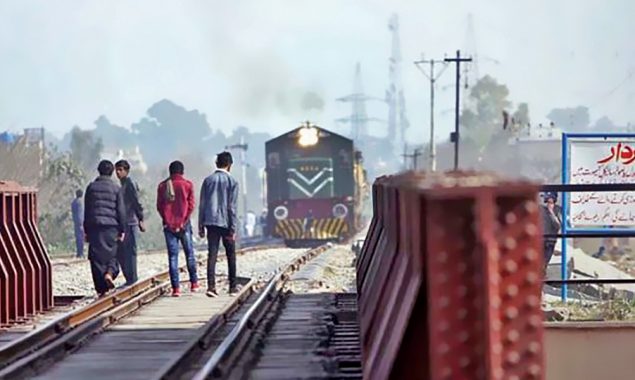
The growing population and reportedly haphazard and unplanned growth along the railway track passing through Rawalpindi city has resulted in a rise in accidents, putting the lives of people living in nearby localities at risk, Bol News has learnt.
Pakistan Railways (PR) officials say that at various points the government land on both sides of the track was encroached upon and houses were built quite close to the track. Due to this, the poorly erected structures shook when the trains passed by and the residents experienced tremors.
Although the PR officials did not have any proper data of the people who had been involved in accidents while crossing the railway line, there was also an issue of people not reporting the matter to police. Victims would not call Rescue 1122. However, during the past year, Rescue 1122 had reported over a dozen cases where at least one person lost their life after being hit by a train. Many of these accidents involved rushing across the railway line at different points in Rawalpindi.
Mohammad Ejaz, a resident of Quaid-i-Azam Colony, which was bifurcated by the main railway line, stated that at certain places, the houses were constructed only a few yards away on both sides of the track, increasing the accident risk as children living in the area used to cross the track several times a day or play there.
He alleged that the railways’ land was encroached upon by the land mafia in connivance with the officials of the department. He questioned how houses could be built so close to the track. However, the railway officials deny the charge and claim that people had constructed houses close to the track but these houses were constructed on their own land. PR Rawalpindi divisional superintendent Inamullah admitted that the unplanned growth on both sides of the railway track had increased the accident risk and people did fall victim to it while crossing the tracks.
He, however, further said that the PR authorities did not have enough resources to fence the whole track as fencing of the track passing through the city was the only plausible solution to the problem.
Growing city
He added that earlier when the cities and towns were small, they would not have such issues. “But now with the rapid population growth along both sides of the track, the accident risk had increased and the authorities concerned could not resolve the issue on a permanent basis. Earlier, the city limits of Rawalpindi culminated at Chaklala … and finished at IJ Principal Road … but now the city limits spread to Rawat. It touches the fringes of Taxila … due to establishment of a number of housing societies and growth of unplanned housing areas.”
However, they do take temporary measures to restrict the movement of people at points where people cross the track more frequently either by digging trenches or fixing iron bars, Inamullah explained. It would not fully serve the purpose as people used to start crossing the tracks from other places. So far they had restricted people’s movement at some 80 points at different places from Peshawar to Rawalpindi. The railway track passing from Wah to Taxila is quite prone to accidents as the houses on both sides of the track were at a height.
Rawalpindi DS Railways said the permanent solution to the problem is complete fencing of the track from Peshawar to Karachi which is part of the Main Line-1 project. The project reportedly included construction of a dual track from Peshawar to Karachi covering around 1,700 kilometres area.
“In the construction of the ML-1 project, we would be making makeshift and temporary arrangements to check the frequent crossing of the railway track at various points.”
He told Bol News that from Peshawar to Lahore, the railway track was passing through thickly populated areas and it would not be possible for them to stop people from crossing the track. “We used to launch awareness campaigns in the localities near the railway track from time to time. But the only solution to the problem is complete fencing of the track which, in the given circumstances, would not be possible as the department was already running in huge losses.”
The construction of the ML-1 project would lay the dual track from Peshawar to Karachi which would enhance the existing speed of the trains from 65km per hour and 105km per hour to 120km per hour and 160km per hour. This would reportedly reduce the travel time between Rawalpindi and Lahore to less than three hours while the travel time from Lahore to Karachi to eight hours.
Read More News On
Catch all the Pakistan News, Breaking News Event and Latest News Updates on The BOL News
Download The BOL News App to get the Daily News Update & Follow us on Google News.




